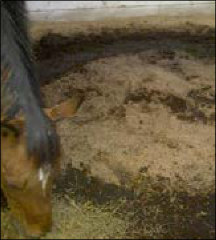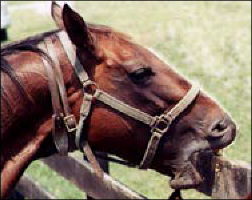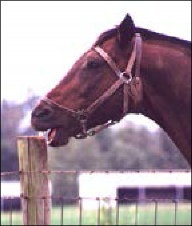Stereotypic Behavior in Horses: Weaving, Stall Walking, and Cribbing
Stereotypic Behavior in Horses: Weaving, Stall Walking, and Cribbing
Author: Fernanda C. Camargo, Animal and Food Sciences
Introduction
Many stabled horses perform a variety of repetitive behaviors such as weaving, stall walking, cribbing, headshaking and pawing. These behaviors have been called many different names including stereotypic behavior, stereotypies, stereotypes, obsessive compulsive disorders, vices and habits. Although it may be difficult to know why exactly each horse performs these vices, there may be specific causal factors for these activities in the horse. These behaviors are not simply learned and not simply inherited, but may be a mixture of both. Studies show that some families of horses have a higher prevalence of certain vices, which suggests heritability and genetic components. However, the tendency to perform the behavior only becomes apparent when other risk factors are also in place.
Risk Factors
- Diet and Feeding Management: It has been shown that horses that eat less than 15 pounds of forage per day are at increased risk of developing abnormal behavior, especially weaving and wood chewing.
- Pasture/Barn Mates: Many horse owners firmly believe that these behaviors are learned from a horse to another, although this connection has not been scientifically demonstrated. What mayhappen is a phenomenon called "social facilitation," in which the introduction to the herd of a new horse with a vice may "release" the unexpressed behavior that another horse may be predisposed to.
- Other Triggers: Other factors have been found to trigger repetitive behaviors. Weaning, starting under saddle training, confinement and isolation are just a few examples.
Weaving and Stall Walking

Weaving is a lateral swinging of the head, neck and forequarters; stall walking is a repetitive circular walking in the stall. The two behaviors are considered to be related, because horses that perform one of these behaviors may also perform the other instead of also performing an oral repetitive behavior. Although people believe that weaving affects performance or puts undue strain on tendons, there is no scientific study to confirm that belief.
A weaver will display its behavior in a predictable manner. It often precedes an arousing event (feeding time), when close social contact is limited but the horse still can see other horses, exercise and feeding allowance are not matched, or bedding is not straw. Repetitive locomotor behaviors are more common when horses are kept in small (< 4 acres) paddocks, with restricted cantering. Some cases of stall walking may be managed if the feeding is made to resemble ambulatory grazing by having piles of hay scattered in the stall or installing foraging devices that induce horses need to spend more time eating. Research suggests that the installation of a mirror inside the stall reduces in many cases the incidence of both weaving and stall walking. It is recommended that the mirror be placed toward the front of the stall so the reflection can be seen as the horse approaches the door.
Following are some tips for treating and preventing weaving and stall walking:
- Increase turn-out and exercise, or manage horse from pasture if possible.
- Use feeding stations around the stall or scatter feed and hay around the stall.
- Try to reduce predictors of the arrival of food, which may be difficult because most if not all barns work on a schedule.
- Introduce a stall mirror if the horse is sociable. (If the horse is anti-social a mirror may increase other undesirable behaviors such as kicking and lunging in the stall.)
- Avoid using anti-weaving grills and other devices, which research shows frustrate horses further.
- Wean gradually rather than abruptly, and wean in groups.
Cribbing
Cribbing is when a horse grabs a solid object (fence, buckets, waterer, etc) with its teeth, stretches its neck and makes a characteristic noise. For years it was thought that horses swallowed a lot of air into their stomach. Research has shown that very little air, if any, is swallowed. Cribbing is a vice. Many believe that there is a genetic predisposition to becoming a
cribber and others feel that it is a learned habit. Cribbers are at increased risk of colic by epiploic foramen entrapment and may have other gastro-intestinal conditions, including ulcers, that may cause both colic and the cribbing behavior.
 Cribbers can also damage trees, fences and stall walls. This vice can be controlled by cribbing straps and collars, distasteful pastes and liquids on the preferred surface, electric fence and surgery. The environment seems to play a critical role in the development and expression of cribbing (and other vices). Horses start to crib as young as weaning time. Feeding concentrates after weaning and creep feeding have been found to increase the risk of cribbing. The stomachs of these foals are more inflamed and ulcerated than those of normal foals. It may also be that concentrates rapidly become acidic in the stomach and reduce the amount of saliva produced, which acts as a buffer in the stomach, as a result of the reduced chewing. For this and many other reasons, it is highly important that horses be offered high-quality long-stem forage. However, horses kept at grass may also crib. This may be because once established, the vice will persist even after the primary cause has been removed.
Cribbers can also damage trees, fences and stall walls. This vice can be controlled by cribbing straps and collars, distasteful pastes and liquids on the preferred surface, electric fence and surgery. The environment seems to play a critical role in the development and expression of cribbing (and other vices). Horses start to crib as young as weaning time. Feeding concentrates after weaning and creep feeding have been found to increase the risk of cribbing. The stomachs of these foals are more inflamed and ulcerated than those of normal foals. It may also be that concentrates rapidly become acidic in the stomach and reduce the amount of saliva produced, which acts as a buffer in the stomach, as a result of the reduced chewing. For this and many other reasons, it is highly important that horses be offered high-quality long-stem forage. However, horses kept at grass may also crib. This may be because once established, the vice will persist even after the primary cause has been removed.

Studies show that horses with stereotypical behaviors have higher level of cortisol (the stress hormone) than normal horses. This high level may mean that these horses are more frustrated and stressed than normal horses. Studies also show that these horses have higher level of circulating endorphins (the feel-good hormone) when they are performing their stereotypical behavior. Therefore, it is difficult to know if a horse cribs to release frustration, or if it is simply an addiction, comparable to smoking.
Cribbing is a tricky issue because there doesn't seem to be any consensus on what causes it or how to curb it. Therefore, following are some tips to managing a cribber:
- Find out if there is an underlying medical issue (gastric ulcers or other sources of abdominal pain) and treat those if present.
- Provide a calm, frustration-free environment where horses can fully express their natural behavior patterns, which include browsing, performing all gaits, playing, foraging, etc.
- Increase forage intake and turn-out on pasture.
- Manage horse from pasture as much as possible.
- Provide social contact.
- Reduce concentrate and sweet feed intake. If concentrates are essential, increase the fat content and decrease the carbohydrate content of the ration.
- Avoid creep feeding of foals.
- Add antacids to concentrate in each meal.
- Use cribbing collars but make sure they fit well and do not cause skin lesions.
It is important to mention that cribbing is not the same as wood chewing, although there are similarities between the two behaviors. Wood chewing may be a vice in stabled and bored horses whose diets do not contain high amounts of fiber; or it may be a normal behavior, since
it is demonstrated in feral horse herds.
Conclusion
There are other types of stereotypes not mentioned in this fact sheet. Stereotypes may be difficult to fully prevent. In adult horses, stereotypes may be more of a scar representing a problem at time of onset instead of ref lecting current problems. Since it appears that young
animals are more sensitive to conditions that elicit stereotypic behavior, it is highly important to address the situation and change managing practices as soon as such behaviors arise. As horses mature, vices are elicited by a wider set of stimuli than in early development (weaning), and become somewhat immune to attempts to control the behavior. Consequently, we see older horses performing these behaviors in environments that provide great welfare. It may not be possible to reverse the process of stereotypical behavior in mature animals, but the amount of time they spend performing the stereotype can be diminished by increasing opportunities for social contact and turn-out time. Therefore, it is important to manage these horses and ensure they are healthy and mentally and physically stimulated. Horses are social animals. Keeping horses together with other horses and providing pasture time and enough forage seem to be pivotal in controlling/managing any stereotypical behavior.
References
Mills, D.S., K.D. Taylor, and J.J. Cooper. 2005. Weaving, Headshaking, Cribbing, and Other Stereotypies. In: 51st Annual Convention of the American Association of Equine Practitioners
Proceedings.
Moore, R.M. 2006. Cribbing in Horses. In: North American Veterinary Conference Proceedings.
Nicol, C.J. 2000. Equine Stereotypies: Recent Advances in Companion Animal Behavior Problems. In: Recent Advances in Companion Animal Behavior Problems, ed. K.A. Houpt. International Veterinary Information Service, Ithaca NY.
Photos by Fernanda C. Camargo and Bob Coleman, Animal and Food Sciences
